Week 4 - Hematopoiesis + Hematology
1/96
There's no tags or description
Looks like no tags are added yet.
Name | Mastery | Learn | Test | Matching | Spaced |
|---|
No study sessions yet.
97 Terms
What is hematopoiesis?
- The process by which blood cells are formed
Where is the main site of hematopoiesis in mammals and most other vertebrates?
- Bone marrow
When/why does extramedullary hematopoiesis occur?
- Occurs when there is increased demand for blood cells
Where does extramedullary hematopoiesis occur?
- Primarily occurs in spleen and liver
Where is bone marrow located?
- Located in flat bones and long bones
Where are bone marrow samples collected from? Provide examples for cats/dogs and large animals.
- Sites with active hematopoietic tissue.
- Dogs/Cats: Iliac crest, proximal femur, humeri
- Horses/ruminants/camelids: Ribs, sternebrae, and ilium
What are the two divisions of bone marrow on gross appearance? Describe them.
1) Red marrow = hematopoeietic tissue and blood vessels, called sinusoids
2) Yellow marrow = Mostly fat
What is cellularity? Describe it in young animals, adult animals, and older animals.
- The ratio of red:yellow marrow
- Young animals: Higher ratio of red>yellow marrow (high cellularity)
- Most adult animals: 1:1 ratio ("normal" cellularity)
- Older animals: Lower ratio of red
What are the two types of bone marrow samples collected? What is the difference in how they are processes?
1) Biopsy for histology: Embedding, sectioning, H&E stain
2) Aspiration (liquid sample) for cytology: Stained with Wright's stain
How was this sample collected?
- Biopsy (There is cellularity, a "big - picture", and architecture.

How was this sample collected?
- Cytology (There is individual cell detail, lineage, nuclei, and maturation)

The hematopoietic stem cell is parent of ________ blood cells. It is a __________ stem cell which gives rise to a restricted set of cells.
- All
- Multipotent
The common myeloid progenitor leads to the production of what cells?
- 4/5 main leukocyte/WBC types (not lymphocytes)
- Erythrocytes/RBCs
- Platelets and their precursors, megakaryocytes (which make platelets)
The first "choice" that a hematopoietic stem cell must make is if it wants to commit to which two lineages?
- Myeloid
- Lymphoid
The common lymphoid progenitor leads to the production of what cells?
- B cells (lymphocyte)
- T cells (lymphocyte)
- Natural killer cells
Mast cells and macrophages are tissue _________ cells which arise from what?
- Resident
- Myeloid progenitors
Osteoclasts, fibroblasts, adipocytes are the _________ __________ of bone marrow.
- Connective tissue
What is erythropoiesis?
- Process of forming new erythrocytes (RBCs)
Mature erythrocytes in mammals are _____________. In this true in other species?
- Anucleate
- No (i.e. birds have a nucleus in theirs)
What is the key cytokine which stimulate erythropoiesis? Where is it made?
- Erythropoietin (EPO)
- Made in the kidneys
When is hemoglobin synthesized?
- Synthesized by erythroid cells as they mature
________ in hemoglobin binds oxygen for transport from lungs to organs. ____________ binds CO2 for transport from organs to lungs.
- Iron
- Globin
Describe the transition of erythroid cell cytoplasm as they mature.
- Deep blue -> Grey/blue -> Orange with increased hemoglobin synthesis
What is myelopoiesis?
- Process of forming new leukocytes (WBCs)
What are the five major types of mature leukocytes in the blood? Which are granulocytes and which are mononuclear cells?
1) Neutrophils: Granulocytes
2) Eosinophils: Granulocytes
3) Basophils: Granulocytes
4) Monocytes: Mononuclear cell
5) Lymphocytes: Mononuclear cell
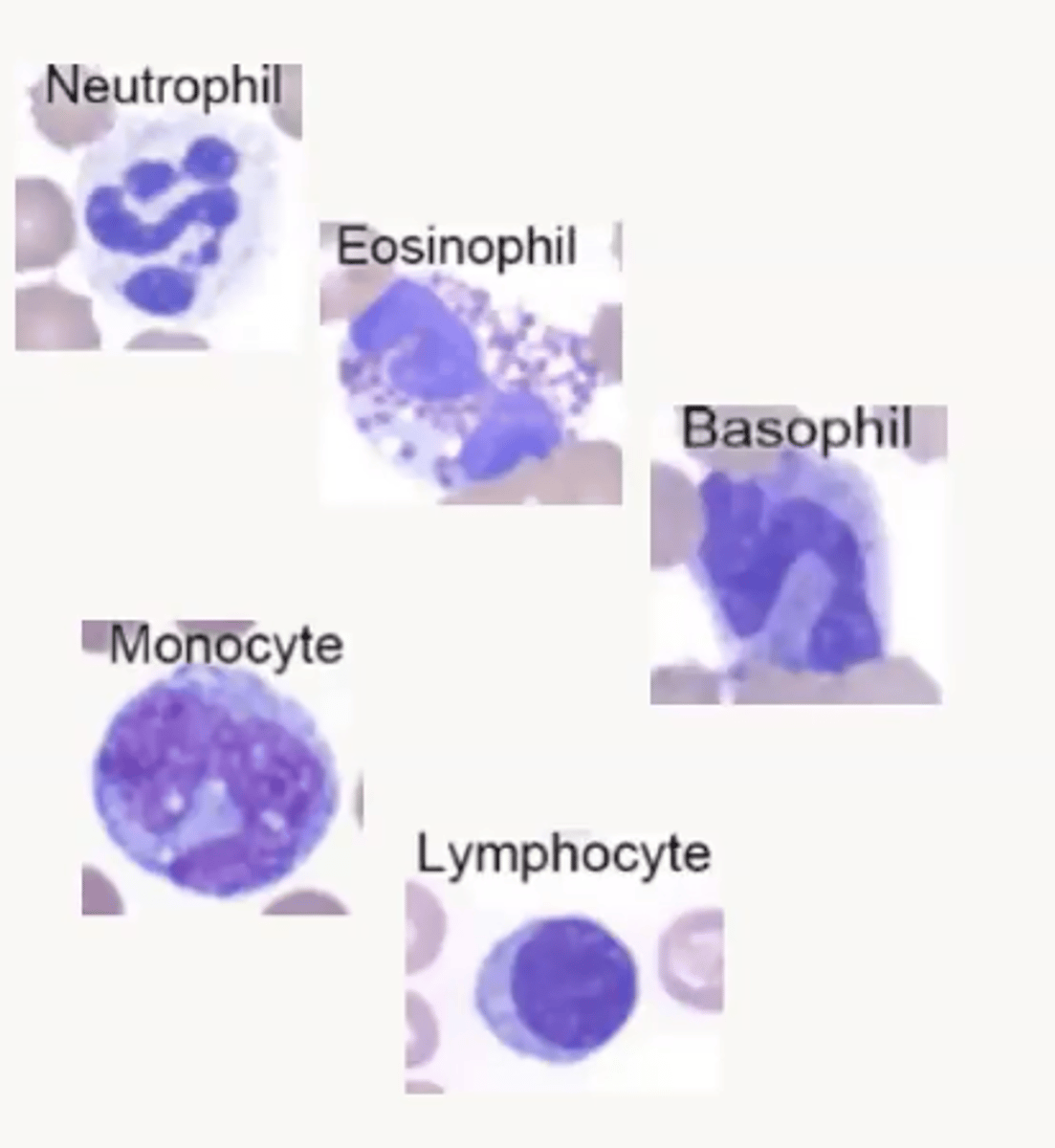
Do mast cells circulate?
- In very low numbers
What two terms are used to describe the process of making specific leukocytes?
- Granulopoiesis
- Lymphopoiesis
Lymphoid progenitor cells arise where? What happens after this?
- In bone marrow
- Some travel to the thymus to make T lymphocytes
- Some remain in bone marrow to make B lymphocytes and natural killer lymphocytes
What is thrombopoiesis?
- Process of forming platelets
Platelets in mammals lack ___________.
- Nuclei
What is the key cytokine for thrombopoiesis and where is it made?
- Thrombopoietin
- Liver and kidneys
Mature megakaryocytes are ______ cells as the result of endomitosis. Their cytoplasmic processes (proplateletes) protrude into nearby blood vesses. What does this allow for?
- Polyploid
- Fragments of megakaryote cytoplasm break off via shear into blood stream, creating platelets

Platelets in non-mammals are called ________ and have ________. Do they arise from megakaryocytes?
- Thrombocytes
- Nuclei
- No
Megakaryocytes are _______ cells while osteoclasts are ___________ cells.
- Polyploid ("nuclei" appear fused)
- Mutlinucleated
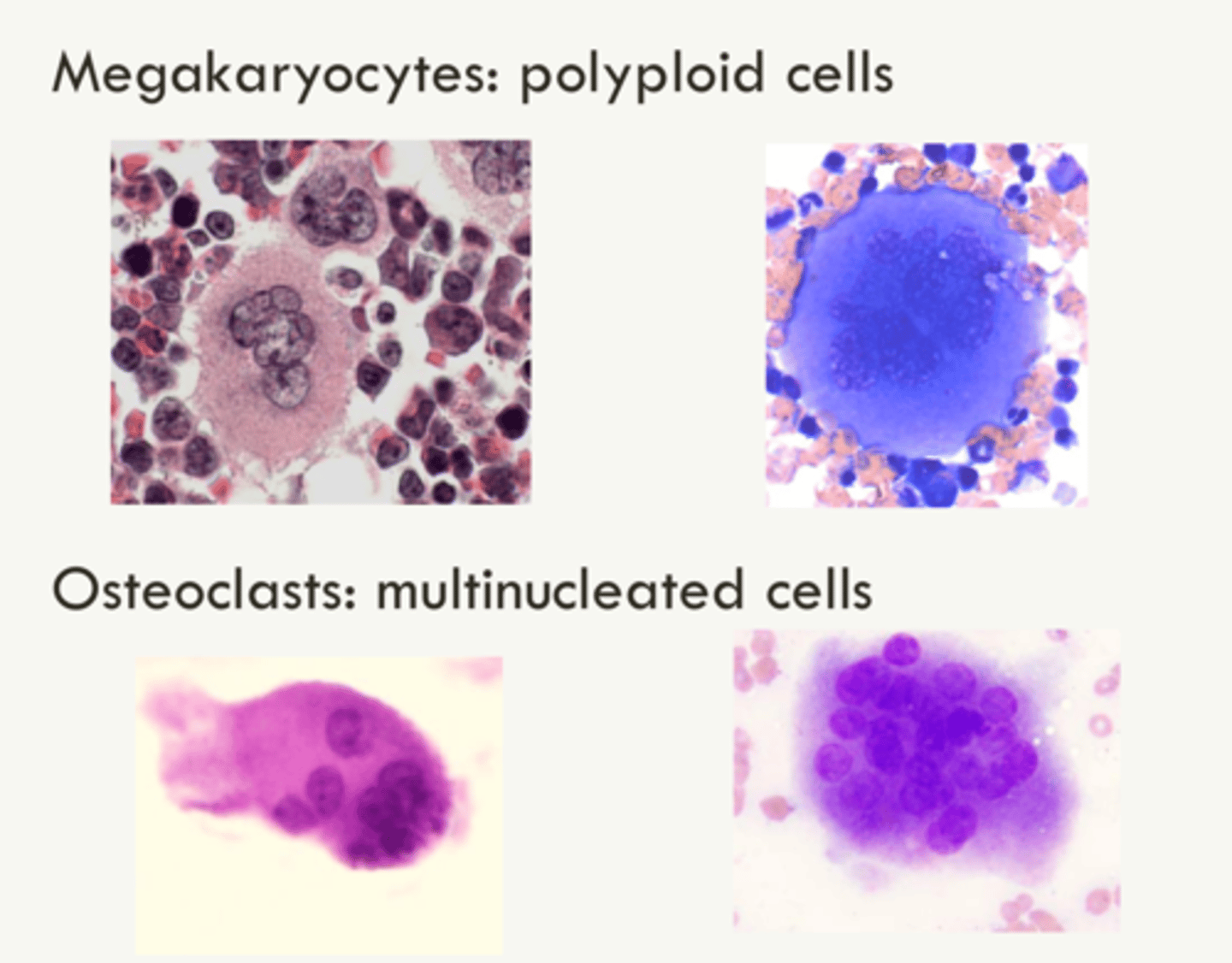
What is hematology?
- The study of blood and blood cells
What two things does a CBC (Complete blood count) include?
1) Automated analysis
2) Visual blood smear examination
A single CBC represents a snapshot of what?
- Of cells traveling in the blood at that moment
What are the two steps of preparing a blood smear for evaluation?
1) Blood smear is prepared with blood in anticoagulant (EDTA) (Purple top)
2) Blood smear is stained with Wright's stain and evaluated (Quick stain)
Most RBCs in circulation are what? What is their shape? How does the center appear?
- Mature erythrocytes
- Biconcave shape
- Center can look pale (central pallor)
Nucleated red blood cells (nRBCs) rarely circulate in health animals. They can circulate in many pathological conditions. The most common nRBS in circulation are what?
- Metarubricytes (most mature stage of nRBCs)
What are reticulocytes and polychromatophils? What is the difference between them?
- RBCs that are anucleate but not fully mature, still actively synthesizing hemoglobin
- The stain: Polychromatophils are identified with a standard hematology stain (Wright's stain). These cells have less hemoglobin (red color) than mature cells and more RNA (blue color). Reticulocytes are identified with a vital stain (e.g. new methylene blue NMB). the reticulum is aggregated RNA that precipitates with a vital stain and stains dark blue.
Which are easier to identify and count, polychromatophils or reticulocytes?
- Reticulocytes
What does an increase in red blood cells indicate?
- Bone marrow regenerative response
If a patient is anemic, there are two possible reasons. What are these?
1) The bone marrow isn't making enough RBCs
2) RBCs are being lost or destroyed peripherally
If a patient is anemic but there is an increase in reticulocytes, is the bone marrow making enough RBCs or are the RBCs being lost/destroyed peripherally.
- RBCs are being lost/destroyed peripherally
What are Howell-Jolly bodies?
- Nuclear remnants in mature RBCs; single dark inclusions

What is basophilic stippling of RBCs?
- Aggregated RNS that stains with Wright's stain. Most common in ruminants, rare in health and increase with regeneration.
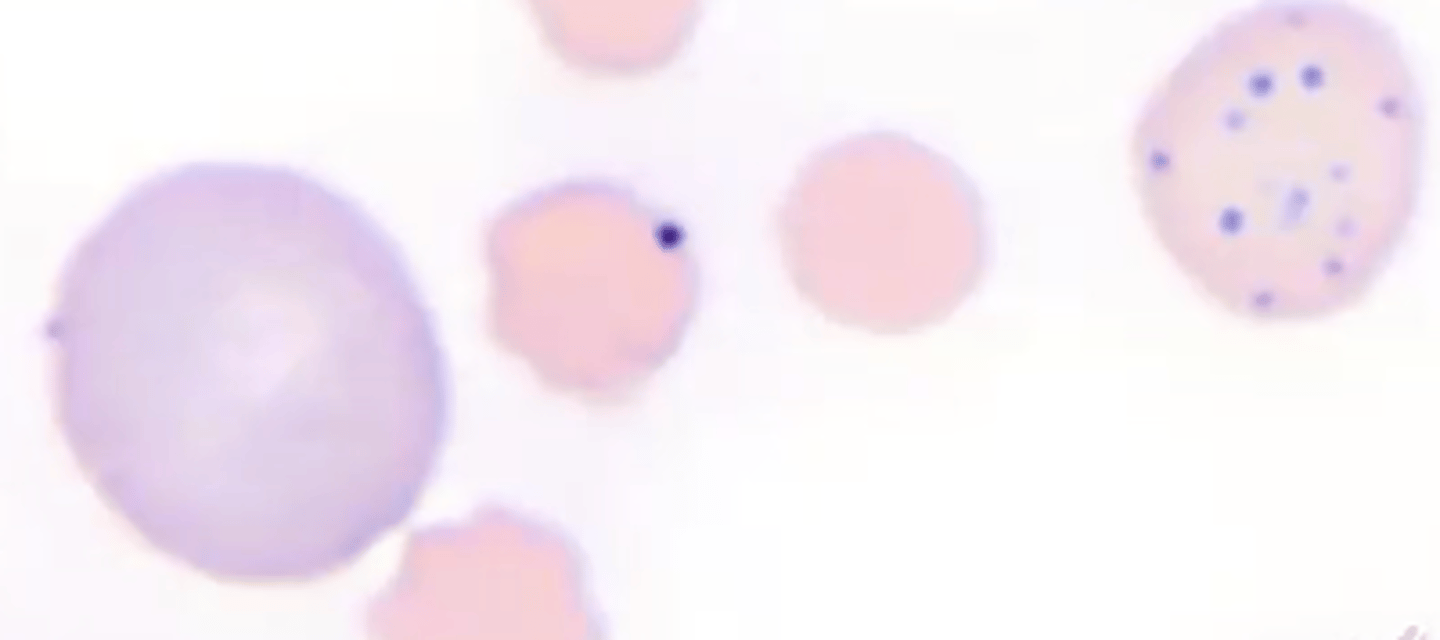
In what conditions can nucleated RBCs be observed?
1) Severe regenerative anemia
2) Bone marrow, splenic disease
What is mean cell volume (MCV)? It varies between what?
- Average size of an RBC
- Between species
Reticulocytes/polychromatophils are _________ than mature RBCs. MCV will __________ if there is a large increase in reticulocyte count. Reticulocytes/polychromatophils have __________ hemoglobin than mature RBCs. If there is a large increase in reticulocyte count, MCV will _________.
- Large
- Increase
- Less
- Decrease
Describe the key differences between RBCs in dogs, cats, horses, and camelids.
- Dogs: RBCs have strongly biconcave shape; have "central pallor"
- Cats: RBCs lack central pallor; They have two types of reticulocytes (punctuate and aggregate)
- Horses: RBCs have minimal central pallor, bone marrow doesn't release reticulocytes
- Camelids: Have elliptical or oval-shaped RBCs
When counting reticulocytes in cats, do you count the punctuate or aggregate reticulocytes?
- Only aggregate retculocytes are counted
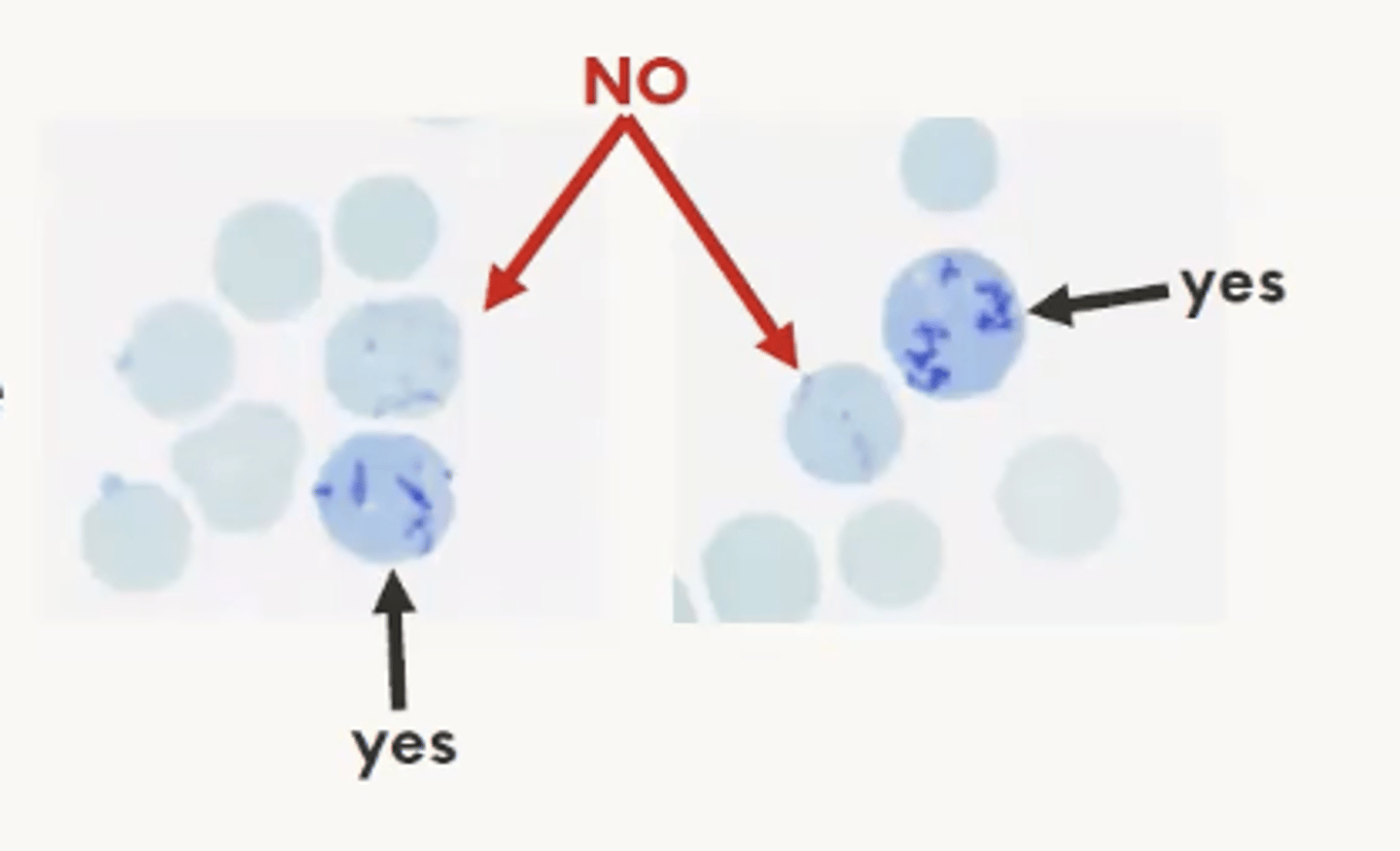
In what species are drepanocytes (aka sickle cells) normal?
- Goats, some sheep, most deer
RBCs (and all cells) ________ each other via negative surface charge. In cats and horses, RBCs have ______ negative surface charge, so the cells stack together like coins, called __________.
- Repel
- Less
- Rouleaux
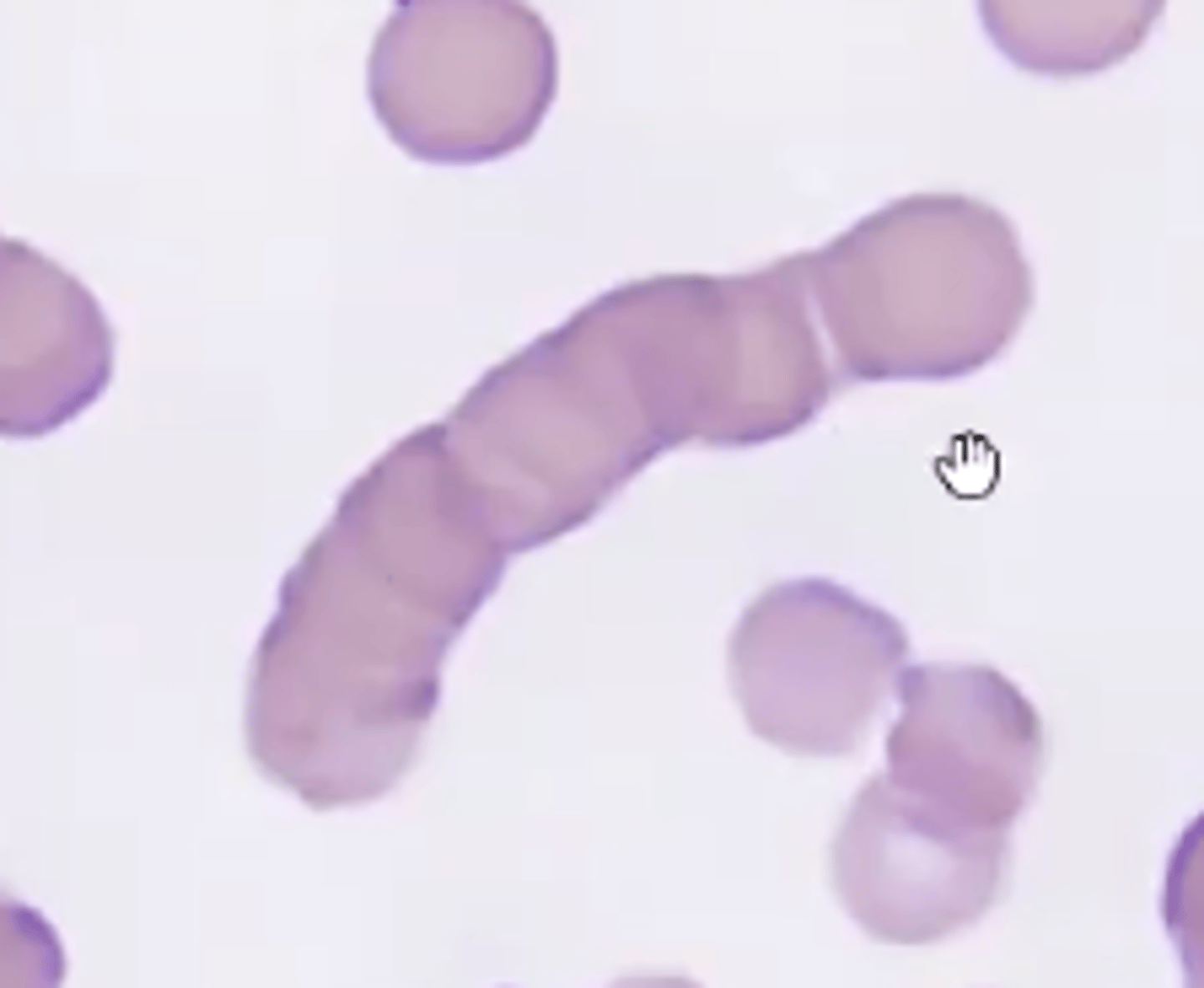
What are heinz bodies? Via what stains can they be observed?
- Hemoglobin is prone to oxidation at -SH groups. Precipitated oxidized hemoglobin pushes RBC membrane outward
- Heinz bodies can be seen in Wright's stained smears, but are easier to find in vital stained smears
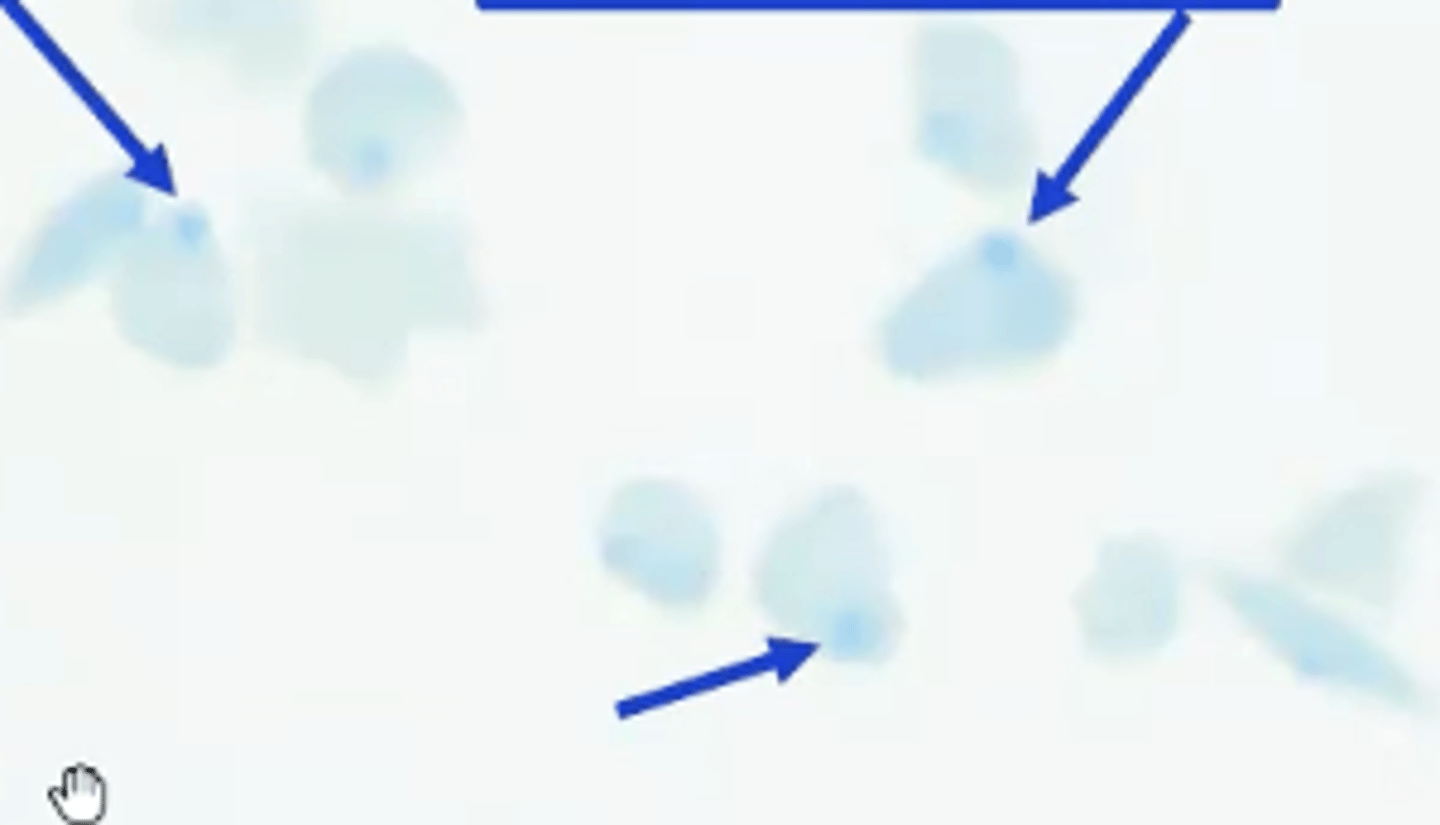
In what species are heinz bodies most common and why?
- Cats
- Cat hemoglobin molecules have more reactive -SH groups
Cats can have up to ______% Heinz bodies normally.
- 10
In non-mammals, can automated cell counters distinguish the three main cell types (RBCs, WBCs, and thrombocytes)? Why?
- No
- They are all nucleated
RBC lifespan is __________ correlated with animal size.
- Partly
RBCs and platelets do their jobs in __________. WBCs do their job ___________.
- Circulation
- Extravascularly
Most white blood cells are on a one-way trip from bone marrow to tissues/organs, and do not re-enter circulation. What is the exception?
- Lymphocytes; They recirculate in blood/lymph
Which WBC has the shortest lifespan? Which has the longest?
- Neutrophils
- Lymphocytes
What are neutrophils?
- Bacterial killing cell
Which is the most abundant granulocyte?
- Neutrophils
Neutrophils ingest bacteria in a process called ___________.
- Phagocytosis
What is particular about the primary granules of neutrophils in most mammals?
- They don't stain well.
Primary and secondary granules of neutrophils contains what?
- "Killer" enzymes
In rare mammals, like rabbits, and all birds/reptiles, what is particular about the neutrophil granules?
- Granules are brightly stained and the cells are called heterophils
Immature neutrophils are released from bone marrow during ___________. This is called a __________ _________.
- Inflammation
- Left shift
What are band neutrophils?
- Are the maturation stage just before mature/segmented neutrophils (shifted one stage to the left)
In the most severe case of left shift, what will be seen in circulation?
- Metamyelocytes
What are the second most abundant granulocyte?
- Eosinophils
What do the granules of eosinophils contain?
- "Killer" enzymes
What is the key difference between eosinophils and neutrophils?
- Eosinophils kills fungi, parasites, and other larger microorganisms while neutrophils kill bacteria
Which granulocyte is involved in allergic reactions?
- Eosinophils
Which is the rarest granulocyte? What is their job?
- Basophils
- Kills fungi, parasites, and other microorganisms (the bigger ones); Involved in allergic, hypersensitivity responses.
The granules of basophils contain what?
- Contain "killer" enzymes and other things such as histamine
What is the smallest WBC? Where are these cells produced from?
- Lymphocytes
- Lymphoid progenitor cells
Lymphocytes are able to __________. They are the cells of the __________ immune system while all other WBCs are part of the _________ immune system
- Learn
- Adaptive
- Innate
Lymphocytes monitor the body how?
- By recirculating from blood into lymphoid organs, then back to blood.
What are lymphocytes divided into? What do these do?
- B cells: Synthesize immunoglobin (antibody), differentiate into plasma cells
- T cells: "Orchestrators of the immune response", include helper and cytotoxic T cells
- Natural killer cells: Part of innate immune system; Only lymphocytes that don't learn
Describe the shape of the nuclei of monocytes.
- Lumpy, amoeba-shaped
Monocytes become what?
- Macrophages or dendritic cells once in organs/tissues
____________ _____________ are common in macrophages.
- Phagocytic vacuoles
Macrophages and dendritic cells are _____________-____________ cells. What does this mean?
- Antigen-presenting
- They eat and kill microorganisms any anything "marked for death" by immunoglobulin
Both macrophages and dendritic cells present antigens to what?
- T lymphocytes
Where are dendritic cells found?
- Where the body contacts the external environment
Where do mast cells arise from? Do they circulate in the blood in high or low numbers?
- Arise from bone marrow myeloid progenitor cells
- Circulate in the blood in very low numbers, then finish maturing in the tissues
What are the functions of mast cells?
- Allergic/hypersensitivity reactions, other acute inflammation, fight parasites and other microorganisms. Release histamine into the bloodstream to trigger changes.
What cells form a clot to stop bleeding?
- Platelets
What is the circulating platelet lifespan?
- 10 days
Platelets form the _________ ________ in a wounded blood vessel. __________ ________ are relased, triggering ________ of platelets into a plug. The plug is then stabilized by a _________ ___________.
- Initial plug
- Platelet granules
- aggregation
- Fibrin mesh
What is the entire process of controlling hemorrhage called?
- Hemostasis
Explain the 10/10/100 rule (best for dogs).
- A neutrophils circulating lifespan is 10 hours, a platelet's is 10 days, and an RBCs is 100 days.
A PCV (packed cell volume) tube separates into what?
1) Plasma - Electrolytes and protein
2) The "buffy coat" - WBCs and platelets
3) RBC fraction - Dark red layer
The PCV or Packed cell volume is the percentage of what?
- Of the blood that is packed RBCs
In what species does PCV testing work?
- All vertebrate species